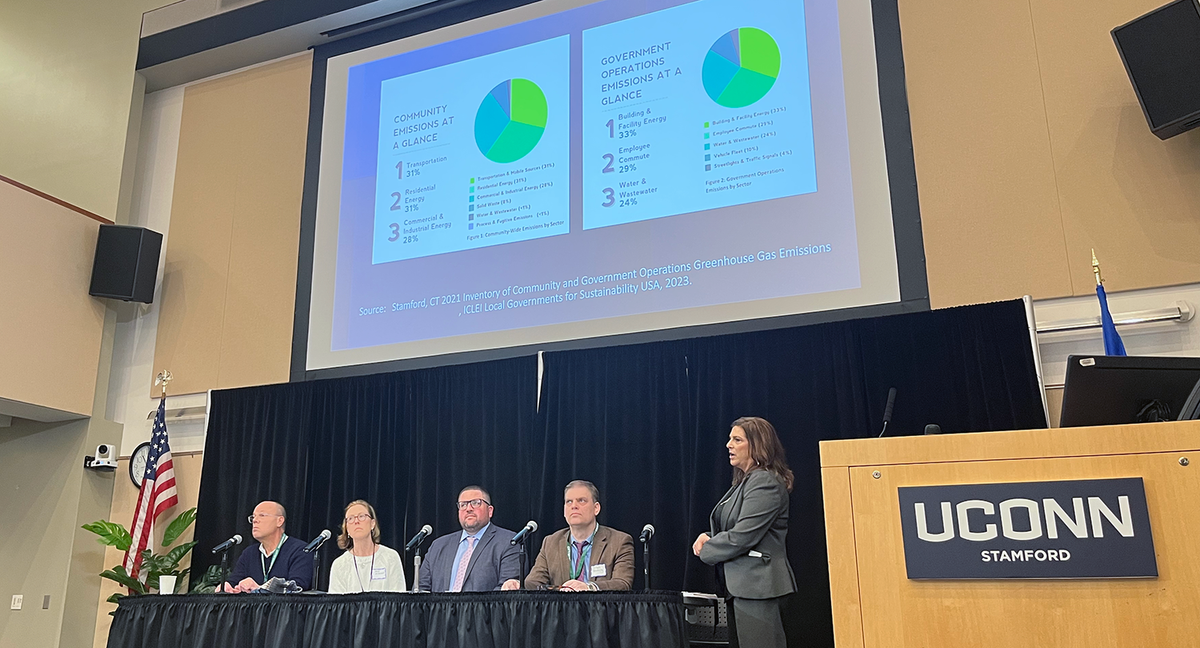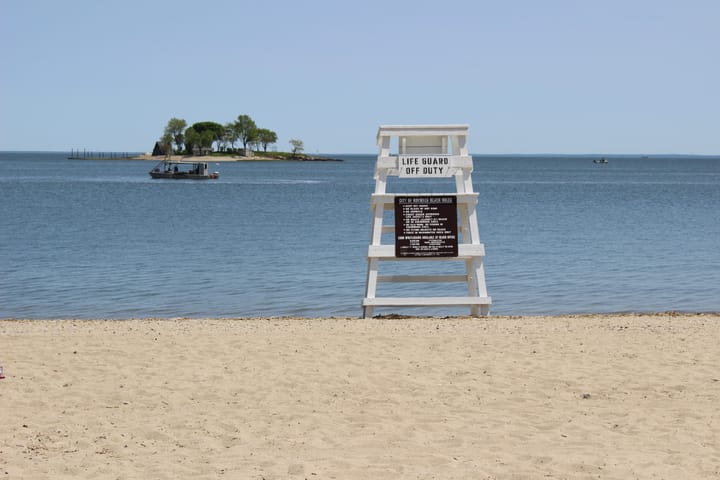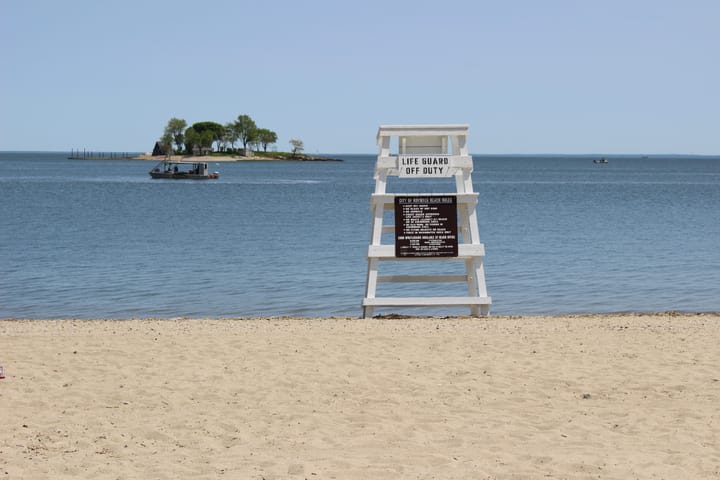How Stamford is Working to Tackle Climate Change Locally
From starting a food scraps collection program to including green infrastructure in projects, Stamford officials highlighted new efforts to be more sustainable.

How will climate change affect us locally? What can be done to mitigate its impacts? These questions were at the heart of Stamford’s first-ever climate summit held on January 25.
“This is perhaps one of the most important moral issues of our time, and the work that we do today is literally going to have implications for our children and grandchildren for generations to come,” Stamford Mayor Caroline Simmons said. “The climate crisis has repercussions on our economy, on public safety, health and wellness of our residents.”
Simmons said her administration is working to make sure that when they “talk about addressing the climate crisis, we also have a strong focus on equity and making sure that environmental justice is built into everything we do so that we can protect disadvantaged communities from this crisis.”
The summit brought together city officials, local partner organizations, and representatives from Connecticut’s Department of Energy and Environmental Protection (DEEP) to highlight some of the challenges Stamford—and surrounding communities along the coast—will face due to a changing climate and what some of the steps the city is taking to try and mitigate its impacts.
‘Climate Change is Here.’
“Coastal cities like Stamford know better than many [that] climate change is here.”
That was the message from DEEP’s Deputy Commissioner Emma Cimino.
“This summer was, unfortunately, an overwhelming example of what we can expect to see in the future,” she said. “2023 was one of the hottest years on record for Connecticut and for the globe, and also one of the wettest in many parts of the state. Stamford alone experienced 150% additional rainfall in July and August, which I probably don't have to tell most of you because you lived it.”
Cimino said that the future estimates call for even wetter years, stronger storms, and higher sea levels which can also increase flooding risks.
“We know that by 2050, Connecticut is projected to experience increasingly stronger storms with more wind and more rain, longer, more frequent droughts, up to 20 inches of sea level rise across the coast, increased frequency of coastal flooding with levels like those seen in Sandy—probably more frequently—and an additional 20 days a year for temperatures rising above 90 degrees,” she said.
Cimino noted that while those projections are scary, “it's important that we act to both anticipate and prevent the worst impacts.”
Stamford’s First Steps
Last Earth Day, Simmons signed the city’s first executive order on climate and sustainability, which directed departments across the city to take actions that would “reduce our city’s carbon footprint and advance sustainability efforts across Stamford.”
“As Connecticut's second [largest] and fastest growing city, we have an obligation to do our part and set an example and reduce our carbon emissions where we can,” she said.
City officials from the land use bureau, transportation, and solid waste and recycling were on hand to outline some of the work that’s already been done.
- Launched and expanded a food scraps recycling program. Dan Colleluori, the city’s supervisor of solid waste and recycling, said that they’re trying to “produce programs that are cost saving, environmentally beneficial, and sustainable.” In the first year, he said they collected about 45,000 pounds of food scraps. The second year, the city collected about 85,000 pounds of food scraps. Stamford received a $2.1 million EPA grant to help expand the program.
- Added sustainability measures into infrastructure projects. Frank Petise, the city’s transportation bureau chief, said that for all transportation projects they’re requiring green infrastructure measures, such as bioswales which help collect and treat stormwater runoff, and new trees to help improve air quality and catch runoff.
- Increased opportunities for active transportation—like walking and biking—instead of using cars. Petise said that there’s currently about $5 million in projects under construction and $50 million worth of projects in design that would improve biking and pedestrian infrastructure across the city. “We need to connect people to places throughout the city, and in order to do that, we need to make connections safe, accessible, and functional for people of all ages and abilities to walk and bike throughout the city.”
- Improved connections to public transit. “We're working with our state partners in Metro North to improve our rail service throughout the city, as well as access to the Transportation Center,” Petise said. “They're also looking into bus routes in the city and replacing bus shelters.”
- Conducted a greenhouse gas inventory and outlined plans to reduce greenhouse gas emissions. The city is also adding electric vehicle chargers across the city, working to transition its fleet of cars to electric vehicles, and converting about 10,000 street lamps to LED lights.
- Added requirements for developments. Ralph Blessing, the city’s land use bureau chief, said that they’ve developed a drainage manual, which directs developers how to manage stormwater, as well as requirements for developers to build sidewalks and add bike parking.
- Focused created dense, transit-oriented development near transit centers. Blessing said that “transit doesn’t work without density, walkable cities don’t exist without density,” as he highlighted the city’s plans to focus development around the train station.
- Invested in tree-related efforts. Erin McKenna, an associate planner in the land use bureau, said that they’re working on a citywide tree inventory, which will help Stamford not only keep track of existing trees but find new places to plant trees.
- Worked on coastal resiliency plans. McKenna said that the city is partnering with CIRCA—Connecticut Institute for Resilience and Climate Adaptation—to develop a coastal flood resiliency plan particularly for neighborhoods south of I-95. The city has also received three state grants from its climate resilience fund for planning efforts in Downtown, West Side, and Waterside neighborhoods; as well as for conceptual designs for reducing stormwater flooding in the Cummings Pond watershed; and evaluating “flooding issues in the Toilsome Brook watershed, specifically in the Ridgeway-Bullshead, Turn of River-Newfield, and Glenbrook-Belltown neighborhoods.
Getting Involved
Simmons emphasized that this summit was only one way for members of the public to get involved with the city’s climate-related efforts. Other ways for residents to get involved include:
- Participating in public forums and workshops around the development of the city’s 10-year comprehensive plan, where residents can help direct Stamford’s planning efforts for the future.
- Advocating for sustainability-related initiatives during the budget process.
- Being a part of public engagement sessions from the Mayor’s Climate Council this spring.
- Attending Earth Day-related activities and events in April.



